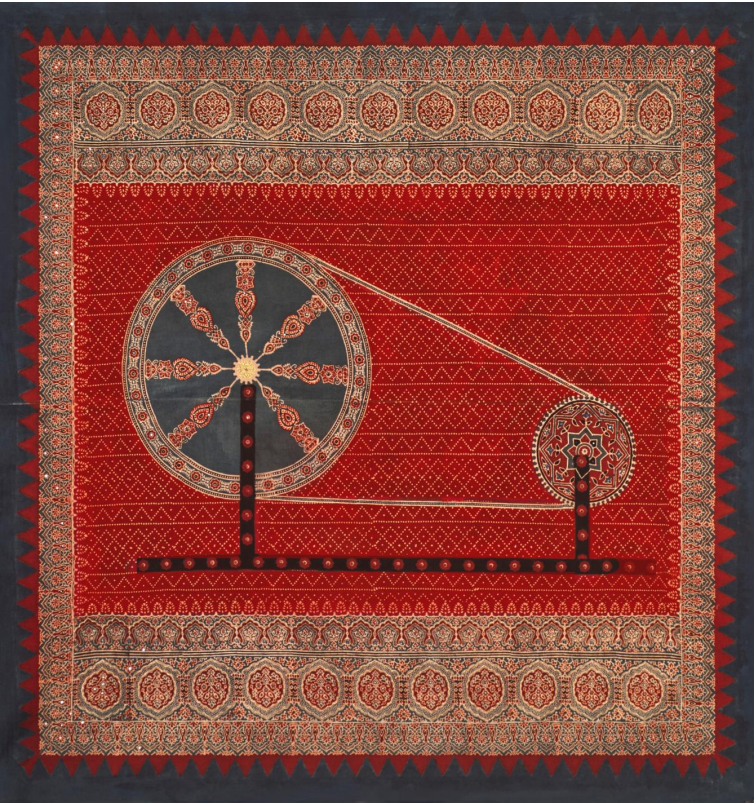The grand inauguration of India’s new Parliament House in New Delhi is not only a historic milestone but also a testament to the nation’s rich art and craft heritage. Amidst the magnificent architecture, a special exhibition awaits visitors at the renowned ‘Shilp Deergha Gallery,’ curated by the esteemed Smt. Jaya Jaitley, Founder and President of the Dastkari Haat Samiti. This collaborative endeavour brings together talented designers and craftspeople to celebrate India’s vibrant traditions through a series of captivating thematic installations. One of the featured artists, Shelly Jyoti, a versatile creative genius known for her expertise in art, fashion design, poetry, and curation, presents her profound artwork inspired by the timeless significance of the charkha.
Taking center stage at the Shilp Deergha Gallery within the ground floor galleries of the New Parliament building, Shelly Jyoti unveils her latest artistic creation, “Charkha – the Wheels of Swavalamban.” Shelly shares, “Charkha is an iconography of being self-sufficient individually and collectively. Working on handspun -woven khadi with ajrakh printing and dyeing along with craftsmen and artisans truly symbolizes the ethos of ‘Make in India’ and swavlamban”
This installation serves as a heartfelt homage to the charkha and embodies the essence of self-reliance. Jyoti masterfully fuses the traditional craft of block printing, specifically Ajrakh, with the symbolism of the spinning wheel. Her artworks, meticulously crafted on hand-spun khadi using the Ajrakh technique, showcase a vibrant palette achieved through resist dyeing methods with natural materials such as lime, gum, rusted iron, and more. The intricate prints feature motifs rooted in centuries-old traditions, delicately embellished with mirrors and zari work.
Collaborating with Ajrakh craftsmen and embroiderers, Shelly Jyoti expresses her deep connection to India’s material and sociopolitical history. With a background in Literature and Fashion & Textile Design, Jyoti has long focused on Mahatma Gandhi’s philosophy of swadharma, sarvodaya, swadeshi, and swaraj. Swavlamban, the concept of self-reliance, has become an extension of her artistic journey. Reflecting on the process of creating this triptych artwork on swavlamban, Jyoti shares, “I am deeply humbled and honored to have been given this remarkable opportunity. I was commissioned by Smt. Jaya Jaitley, the founder and president of Dastkari Haat Samiti, to create these artworks on the theme of swavlambhan for the new Parliament House. Depicting the essence of self-reliance, this installation is a triptych titled ‘Charkha – the Wheels of Swavalamban..
With the invaluable support of my ajrakh craftsmen, including Juned Khatri, and talented embroiderers, I sought to evoke the sentiment that reminds us of the hard-won freedom and the importance of preserving it through self-reliance.”
Visitors to the Shilp Deergha Gallery will be captivated by the mesmerizing artworks of Shelly Jyoti. These pieces beautifully combine the age-old techniques of Ajrakh block printing and intricate embroidery on handwoven khadi. The exhibition aims to deepen the connection between art enthusiasts, historians, and India’s rich cultural heritage. Through the fusion of Ajrakh’s geometric prints, delicate mirrors, and zari work, Jyoti’s artworks evoke the struggles and triumphs that have shaped the nation’s journey towards freedom and self-reliance.
Immersing themselves in the world of Ajrakh, visitors will witness the meticulous artistry and dedication that goes into creating each masterpiece. Ajrakh, a revered technique of reverse block printing with natural dyes, exemplifies the artisans’ resilience in the face of industrial progress. Rooted in Gujarat’s Ajrakhpur, Rajasthan, and Sindh, this heritage craft showcases intricate geometric prints in shades of blue, red, white, and black. The dyeing process, which takes several days, involves harmonizing with nature and utilizing the sun, river, animals, trees, and mud. Ajrakh’s vibrant patterns reflect a deep connection with tradition, employing 20 intricate steps to achieve its unique beauty.
The exhibition of “Charkha – the Wheels of Swavalamban” at the Shilp Deergha Gallery within the New Parliament building invites all to embrace the rich tapestry of India’s cultural heritage. Shelly Jyoti’s artistic vision, infused with her extensive exploration of India’s material and sociopolitical history, is brought to life in collaboration with the skilled Ajrakh craftsmen. Together, they illuminate the significance of the charkha and symbolize the spirit of self-reliance and the “Make in India” initiative. Using khadi as the canvas, Jyoti’s artworks showcase traditional dyeing and embroidery techniques, enveloping India’s intricate past with symbolic forms and sumptuously decorated surfaces.
For many artists in urban India, collaborating with artisans living in rural or tribal areas has been an invaluable way to enrich their creative practice. Shelly Jyoti, with her profound educational background in Literature and Fashion & Textile Design, has nurtured a deep interest in India’s material and sociopolitical history, which has been a driving force behind her textile work over the past several decades. Her works have focused on Mahatma Gandhi’s philosophy of swadharma, sarvodaya, swadeshi, and swaraj, and now, Swavlamban has become an extension of her artistic journey. With the charkha as an iconic symbol of individual and collective self-sufficiency, Jyoti collaborates with Ajrakh craftsmen, working on khadi to convey Gandhi’s message to humanity, encapsulating the essence of “Make in India.”
Jyoti’s innovative use of Khadi as the foundation for traditional dyeing and embroidery processes illuminates various aspects of India’s long and complex history. Through her symbolic forms and exquisitely adorned surfaces, she brings forth the rich tapestry of India’s cultural heritage, inviting viewers to immerse themselves in the profound stories that these artworks tell.








